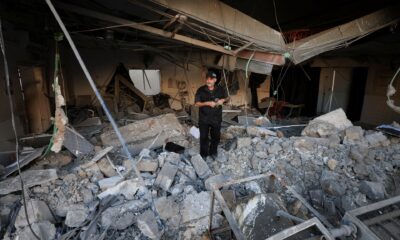Middle East
Israel cuts off Rafah, issues new forced displacement orders for Gaza | Israel-Palestine conflict News

The army says it completed the Morag Corridor as it threatens to expand its operations to ‘most of Gaza’s territory.’
The Israeli military has said it completed the construction of what it calls the Morag Corridor, which cuts off the city of Rafah from the rest of Gaza, as it expanded its attacks on the southern part of the Strip.
The Israeli army’s Arabic language spokesperson on Saturday issued new forced displacement orders for several neighbourhoods in Khan Younis, warning of an imminent attack “with great force” in response to alleged Hamas rockets fired at Israel from this area.
Residents in Qizan an-Najjar, Qizan Abu Rashwan, al-Salam, al-Manara, al-Qurain, Maen, al-Batn al-Sameen, Jurt al-Lot, al-Fakhari and the southern neighbourhoods of Bani Suheila were ordered to leave their homes and proceed to al-Mawasi, on Gaza’s sea coast.
The announcement came amid a barrage of drone attacks and artillery shelling on Khan Younis that killed at least two people.
Israel’s Defence Minister Israel Katz said the Morag Corridor effectively turned Rafah into an “Israeli security zone” and added that the Netzarim Corridor, which divides the Strip in two, would also be expanded.
“Willful passage” will be granted for Palestinians who wish to flee Gaza, Katz said in a statement, mentioning again US President Trump’s plan to remove Palestinians from Gaza.
Katz told Gaza’s besieged population he was offering them the “last chance to banish Hamas and release all hostages, stopping the war,” or else Israeli operations will spread to “most of Gaza’s territory”.
Hamas issued a statement accusing Prime Minister Benjamin Netanyahu of prolonging the war despite repeated calls from within Israeli society to halt the conflict. “The equation is clear: the release of captives in exchange for a cessation of the war. The world accepts it, but Netanyahu rejects it,” it said.
“The blood of Gaza’s children and the occupation’s prisoners are victims of Netanyahu’s ambitions to remain in power and to escape prosecution”.
Al Jazeera’s Nour Odeh, reporting from Jordan’s capital Amman, said the Israeli defence minister had given Palestinians an ultimatum. “Topple Hamas and deliver the Israeli captives, Katz said, that’s the only way to end the war,” Odeh said.
About 2.1 million Palestinians are now squeezed into about one-third of Gaza and no trucks carrying aid, food, cooking gas, or fuel have entered the Strip since Israel reimposed a blockade last month. Katz has publicly stated that, since breaking the ceasefire with Hamas on March 18, Israel’s goal has been to apply pressure on the civilian population, the correspondent added.
Robert Geist Pinfold, a lecturer in international security at King’s College London, told Al Jazeera that while Israel says the creation of the Morag Corridor is purely operational and meant to constrain Hamas, it appears to be part of a longer-term Israeli strategy to control Gaza from afar.
“Israel has always sought to control the Gaza Strip, particularly to oversee what comes in and what comes out and ‘security’ over the territories, as Israel would call it,” he said.
“These [Morag, Netzarim and Philadelphi] corridors are named after settlements, and the settlements did not appear there randomly. They were put there for this specific purpose: to cut off Gaza’s urban areas and give Israel the ability to squeeze the territory when and if it desires.”
Middle East
Hamas ‘studying’ Israeli ceasefire proposal, demand to disarm a ‘red line’ | Israel-Palestine conflict News

Hamas says latest Israeli ceasefire proposal demanding the Palestinian group disarm crosses ‘a million red lines’.
Negotiations for a renewed ceasefire and an end to the war in Gaza appear to be at an impasse after Israel issued new demands for Hamas to disarm in its latest proposal that offers only a temporary halt to attacks on the Palestinian territory, where the death toll is quickly approaching at least 51,000.
Israel issued its latest proposal to Egyptian and Qatari mediators on Monday, offering a 45-day temporary ceasefire in exchange for Hamas releasing 11 Israeli captives still held in Gaza.
Hamas said in a statement that it was reviewing the latest Israeli proposal and would respond as “soon as possible”.
Senior Hamas official Sami Abu Zuhri told Al Jazeera prior to the release of the official statement that Hamas would not accept any demand to disarm, saying that “as long as there is an occupation, the resistance will continue”.
“The request to disarm Hamas is not even acceptable to hear. This is not just a red line, it is a million red lines,” Abu Zuhri said. “Everyone should understand that this is a dream – daydreaming. It cannot be achieved.”
Hamas has insisted that Israel commit to ending the war and remove its forces from Gaza. In return, it has offered to hand over all remaining captives “in one batch”.
Al Jazeera correspondent Nour Odeh said the demand that Hamas disarm was likely a non-starter after Israel publicly outlined a plan to forcibly expel Palestinians from Gaza.
“While Palestinians are listening to Israel talking about ethnically cleansing the enclave of its Palestinian population, forming a department in the Ministry of Defence to achieve that goal, it is difficult to see any Palestinian group talking about laying down arms in the absence of any political horizon,” Odeh said.
“So for now, Hamas is saying the arms, the issue of disarming, is a red line, and there is no way to talk about that without talking about an end to the war.”
The latest round of talks held in Cairo on Monday ended with no apparent movement towards permanently ending the war, which has escalated since Israel broke the ceasefire in Gaza on March 18 following a deal that was reached with Hamas in late January.
Since restarting the war, Israel has killed more than 1,500 Palestinians according to Gaza health authorities. Gaza’s Ministry of Health says at least 50,983 Palestinians are confirmed dead and 116,274 wounded in Israel’s war on Gaza.
Hundreds of thousands of people have again been displaced since Israel resumed its campaign as well as imposed a total blockade on Gaza, forcing the territory into a state of siege and starvation.
Middle East
Islamabad seeks answers after eight Pakistanis shot dead in Iran | Armed Groups News

Islamabad, Pakistan – Pakistan has urged Iran to conduct a “comprehensive investigation” after eight Pakistani migrant workers were killed over the weekend in Iran’s Sistan-Baluchestan province, which shares a border with Pakistan’s southwestern Balochistan province.
The attack took place on Saturday in Mehrestan county, located roughly 230km (142 miles) from the Pakistan border, where unidentified assailants attacked a workshop.
According to Iranian media reports, all eight workers – who belonged to various areas of Pakistan’s Punjab province and were working as mechanics – were tied up and shot dead.
The Baloch Nationalist Army (BNA), a lesser-known Baloch group seeking independence from Pakistan, has claimed responsibility for the attack.
Iran and Pakistan were both quick to condemn the attack, with the Iranian ambassador to Pakistan, Reza Amiri Moghadam, saying “terrorism is a common threat throughout the region”.
The Pakistani envoy to Tehran, Mudassir Tipu, confirmed in a statement on X that the two countries were coordinating efforts to investigate the incident.
Earlier, Pakistan’s Ministry of Foreign Affairs had sought a joint response against the attackers. “Pakistan strongly condemns the inhumane and cowardly killing of its nationals in Iran. We hope for the Iranian side’s full cooperation in investigating the matter and in the timely repatriation of victims’ remains,” it said in a statement on Sunday.
Yet experts say the deadly attack only underscored the tense security landscape along their shared border — where the two countries traded missile fire last year, accusing each other of harbouring deadly armed groups.
Statement of the Embassy of the Islamic Republic of Iran to Pakistan:
The Embassy of the Islamic Republic of Iran strongly condemns the inhumane and cowardly armed incident against 8 Pakistani nationals in Iran’s Sistan and Balouchestan province.
Terrorism is a chronic plight… pic.twitter.com/qbjXe6Q3TC— Reza Amiri Moghadam (@IranAmbPak) April 13, 2025
Rising tensions along the border
The Pakistan-Iran border has been tense since January 2024, when Iran launched attacks on Pakistani soil.
The Iranian government said it was targeting Jaish al-Adl, an armed group it accuses of carrying out multiple attacks in Iran. Pakistan responded a day later with a retaliatory attack that it said was based on “credible intelligence” regarding “impending large-scale terrorist activities” from across the border.
Just days after the exchange, at least nine Pakistani labourers were killed in Iran’s Saravan region by unidentified men in a strikingly similar act of violence to the Mehrestan incident.
Balochistan, a region that spans parts of Iran and Afghanistan, has experienced a surge in violence over the past year, with the secessionist group Balochistan Liberation Army (BLA) (BLA) carrying out several large-scale attacks.
Last month, the BLA launched an audacious attack by hijacking the Jaffer Express, a Pakistani passenger train carrying about 400 people. Following an operation that lasted more than 24 hours, Pakistani security forces overcame the hijacking, eliminating at least 33 attackers. Thirty people, including 26 passengers and four security personnel, were also killed.
Balochistan is home to about 15 million of Pakistan’s estimated 240 million people, according to the 2023 census. Yet, it remains the country’s poorest region despite its wealth in natural resources, including coal, gold, copper, and gas.
It also hosts one of Pakistan’s major deep-sea ports at Gwadar, a critical hub in the $62bn China-Pakistan Economic Corridor (CPEC), designed to connect southwestern China to the Arabian Sea through Pakistan.
Baloch nationalist groups allege that the Pakistani state has neglected their people while exploiting the province’s resources, fuelling separatist movements and armed rebellions. Baloch activists also accuse the government of human rights violations and of being behind forced disappearances — a charge that Pakistan’s government denies.
BNA’s attempt to reassert presence?
Mehsud, who is also a co-founder of The Khorasan Diary, a security research portal, added that while Tehran insists that it does not harbour Baloch armed separatists, multiple incidents over the past 15 months suggest that Baloch secessionist groups are active on Iran’s side of the border.
While the BLA remains the most potent group in Balochistan, targeting law enforcement personnel as well as Chinese interests, Mehsud said the BNA — the group that claimed Saturday’s attack — is smaller, with more limited resources.
There is no evidence to suggest that Iran is in any way supportive of the BNA. In fact, the Baloch group views Iran, as it views Pakistan, as an occupier.
“BNA has faced internal divisions in the past as well and lags significantly behind BLA in terms of fighter strength, including suicide squads, financial resources, propaganda capabilities, and weapon availability,” Mehsud added.
He believes the latest attack may be an attempt by the BNA to reassert its presence.
Baloch rebels a threat to Iran too
The Islamabad-based analyst adds that although the BNA is opposed to Iran, its threat to Tehran’s interests appears limited compared with Jaish al-Adl, a Baloch group that has repeatedly attacked Iran in the past.
That, he said, might explain Iran’s approach to the two groups — prioritising one as a security threat over the other.
“Iran’s response to these groups differs significantly, persistently targeting Jaish al-Adl while seemingly not taking action against the BNA,” Mehsud said.
Still, following the April 12 attack, Iran has been firm in seeking a regional response to armed groups — which creates the possibility of greater coordination between Tehran and Islamabad in addressing security threats on both sides of the border.
“Combating this ominous phenomenon requires collective and joint efforts by all countries to eradicate all forms of terrorism and extremism that have claimed the lives of thousands of innocent people in recent decades,” Moghadam, the Iranian ambassador in Pakistan, wrote on X.
Middle East
Iran to consult Russia on US nuclear talks, Rome may host next meeting | United Nations News

Tehran’s foreign minister will travel to Moscow this week for consultations over Iran’s nuclear talks with the United States, Iran and Russia have announced.
Abbas Araghchi will visit the Iranian ally later this week, Iran’s Ministry of Foreign Affairs said on Monday. The announcement of the trip – during which Araghchi will meet his Russian counterpart, Sergey Lavrov, Moscow said – came as details emerged regarding a second set of talks between Iran and the United States to follow up on an initial meeting over the weekend in Oman.
Araghchi’s visit to Russia “was planned in advance, but there will be consultations regarding the talks with the US”, Iranian Foreign Ministry spokesman Esmaeil Baghaei said.
Iran and the US said over the weekend that they had held “positive” and “constructive” talks although the negotiations remain indirect with Oman acting as mediator.
The two nations have agreed to reconvene on Saturday with reports on Monday suggesting that Rome will play host, though Iran reportedly prefers Geneva.
The US and its Western allies accuse Iran of seeking to use its nuclear programme to develop weapons. Tehran says the work has only civilian purposes.
Iran’s diplomatic efforts to resolve the nuclear dispute and lift sanctions on its struggling economy have accelerated amid demands from US President Donald Trump, which have come with threats of military action.
Russia, a veto-wielding permanent member of the United Nations Security Council, has played a role in recent years in nuclear negotiations between the West and Iran.
As an ally of Tehran, it was a signatory to a 2015 nuclear agreement that saw international inspections agreed and sanctions eased, but Trump abandoned the deal during his first term as president in 2018.
Amid the renewed negotiations between Iran and the US, Moscow has called for a focus on diplomatic contacts instead of actions that it said may lead to an escalation.
The Russian Ministry of Foreign Affairs confirmed on Monday that Foreign Minister Lavrov will meet Araghchi.
“We are expecting Iranian colleagues, talks with Sergey Lavrov as well as meetings with Russian officials are planned,” ministry spokeswoman Maria Zakharova said.
The meetings in Moscow extend the contacts between the allies regarding the nuclear talks. Shortly before the meeting in Oman, Russia and Iran had been joined by China in the consultations.
In contrast, Washington’s Western allies, already sidelined by Trump in talks over the war in Ukraine, are seeking to avoid a similar fate regarding Iran.
French Foreign Minister Jean-Noel Barrot asserted on Monday that European states will be watching closely as the negotiations continue.
“We will be vigilant along with our British and German friends and partners to ensure that any [US-Iran] negotiations that may take place comply with our security interests with regard to Iran’s nuclear programme,” Barrot said as he arrived for a European Union foreign ministers meeting in Luxembourg.
France, Germany the United Kingdom and European Union negotiated the 2015 nuclear agreement together with Iran, China, Russia and the US.
Meanwhile, UN nuclear watchdog chief Rafael Grossi will visit Tehran on Wednesday to meet Araghchi and other senior officials, Iranian officials said.
The International Atomic Energy Agency (IAEA) director general, who last visited Iran in November when he held talks with officials who included President Masoud Pezeshkian, said on social media: “Continued engagement and cooperation with the Agency is essential at a time when diplomatic solutions are urgently needed.”
In a report in February, the IAEA said Iran had an estimated 274.8kg (605lb) of uranium enriched to up to 60 percent, close to the 90 percent level needed to make nuclear weapons.
Ambiguous signals
Before the next round of talks, Iran and the US continue to offer ambiguous signals.
Iran has yet to confirm the location of the next round of talks, but sources have reportedly told media that the discussions will be held in Rome.
Baghaei said, like the negotiations in Oman, the next round would remain indirect under Omani mediation. Direct talks are “not effective” and “not useful”, the Foreign Ministry spokesman said.
Tehran continues to insist that the talks will remain focused solely on the “nuclear issue and lifting of sanctions” and Iran “will not have any talks with the American side on any other issue”.
Trump said the talks were “going OK” and told reporters in the US on Sunday that after meeting with advisers, he expected a quick decision on the nuclear programme.
-

 Europe2 days ago
Europe2 days agoRussian strikes on northeastern Ukrainian city of Sumy kill 32, in deadliest attack this year
-

 Middle East2 days ago
Middle East2 days agoTimeline: Israel’s attacks on hospitals throughout its war on Gaza | Israel-Palestine conflict News
-

 Sports2 days ago
Sports2 days ago‘He’s out of his mind right now’: Rory McIlroy blazes to historic third round lead at the Masters
-

 Sports2 days ago
Sports2 days agoFan controversially rips ball from Mike Trout’s glove and Los Angeles Dodgers suffer record-breaking defeat
-

 Middle East1 day ago
Middle East1 day agoSudan’s RSF claims control of famine-hit Zamzam camp in Darfur | Sudan war News
-

 Europe2 days ago
Europe2 days agoGreece: Bomb goes off outside Hellenic Train offices in Athens, no injuries
-

 Education10 hours ago
Education10 hours agoHarvard rejects Trump administration demands amid threats of funding cuts
-

 Middle East15 hours ago
Middle East15 hours agoIslamabad seeks answers after eight Pakistanis shot dead in Iran | Armed Groups News




